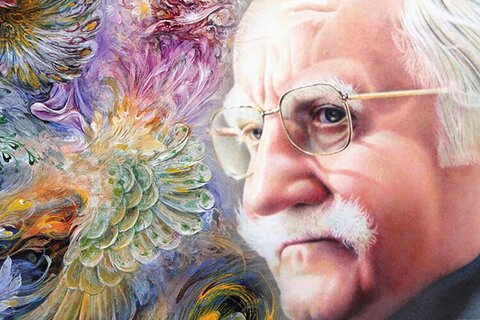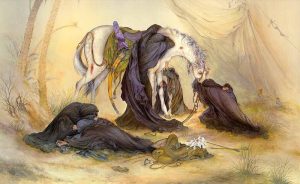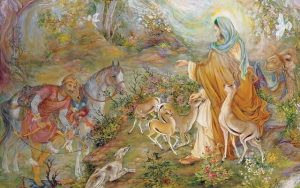Master Mahmoud Farshchian: On August 9, 2025 (18 Mordad 1404), the art world lost one of its most revered figures, Master Mahmoud Farshchian, a luminary whose work transcended cultural and geographical boundaries.
His passing at the age of 95 in the United States, due to pneumonia, marked the end of an era for Persian miniature painting and Iranian art. Master Mahmoud Farshchian was not only a celebrated artist in Iran but also a global icon whose innovative approach to traditional Persian art captivated audiences worldwide.
Master Mahmoud Farshchian’s Early Life and Artistic Beginnings
Born on January 24, 1930, in Isfahan, Iran, Mahmoud Farshchian grew up in a family that cherished art. His father, Gholamreza, a Persian carpet merchant, introduced him to the intricate world of design and aesthetics.
From a young age, Farshchian displayed an extraordinary talent for painting, often spending hours in his childhood home’s “Chicken House,” where he observed birds—an element that later became a recurring motif in his works.
His early exposure to the vibrant patterns of Persian carpets and the cultural richness of Isfahan shaped his artistic sensibilities.
Farshchian’s formal training began at the Isfahan School of Fine Arts, where he studied under masters like Haji Mirza-Agha Emami and Isa Bahadori.
These mentors instilled in him a deep appreciation for the classical techniques of Persian miniature painting, characterized by intricate details, vivid colors, and narrative depth.
Eager to expand his horizons, Farshchian traveled to Europe, spending seven years in Vienna, Austria, studying Western art.
This exposure to global artistic traditions allowed him to develop a unique style that fused Persian classical forms with contemporary aesthetics, setting him apart as a visionary artist. you can read more about this topic here.
The Artistic Philosophy of Mahmoud Farshchian
Mahmoud Farshchian’s work was deeply influenced by his spiritual and philosophical outlook. He believed that art should transcend mere aesthetics and serve as a medium for expressing profound human emotions and spiritual truths.
Drawing inspiration from Persian poetry, Islamic sacred texts, and mystical traditions, Farshchian infused his paintings with a sense of divinity and universality.
His philosophy centered on the idea that art could bridge cultural divides, bringing people closer to the essence of humanity and spirituality.
Farshchian’s commitment to preserving the authenticity of Persian miniature painting while innovating its techniques was revolutionary.
He liberated the art form from its traditional dependence on poetry and literature, giving it an independent voice that resonated on the global stage. His paintings are characterized by their dynamic compositions, vibrant colors, and intricate details, which evoke a sense of movement and emotion.
This innovative approach earned him international acclaim and established him as a pioneer in modern Persian art.
Mahmoud Farshchian’s Global Recognition
Mahmoud Farshchian’s contributions to art extended far beyond Iran’s borders. His works have been exhibited in over 57 solo exhibitions and 86 group shows across Iran, Europe, Asia, and the Americas.
His paintings are housed in prestigious museums, private collections, and cultural institutions worldwide, including those owned by notable figures such as Prince Akihito of Japan, Queen Elizabeth II, and Queen Juliana of the Netherlands.
The establishment of the Master Mahmoud Farshchian Museum at the Sa’dabad Cultural-Historical Complex in Tehran in 2001 is a testament to his enduring legacy, showcasing over seventy of his masterpieces to art enthusiasts globally.
Farshchian’s ability to convey universal themes through a distinctly Iranian lens made him a global ambassador of Persian culture.
His works, such as Zamen Ahoo (The Deer Guardian), The Fifth Day of Creation, and Ghadir Khumm, reflect a deep connection to Iranian heritage while appealing to diverse audiences.
His role in designing the ornate shrines of Imam Hussain and Imam Reza further cemented his status as a cultural icon, as these works symbolize his devotion to Iranian religious and artistic traditions.
The Masterpiece: Noon of Ashura
Among Mahmoud Farshchian’s vast oeuvre, Noon of Ashura stands out as one of his most powerful and emotionally resonant works.
This painting, created with meticulous attention to detail, depicts the tragic aftermath of the Battle of Karbala, a pivotal event in Shiite Islam.
The artwork captures the profound sorrow and sacrifice associated with the martyrdom of Imam Hussain, a central figure in Islamic history.
Farshchian’s portrayal of this moment is both heart-wrenching and spiritually uplifting, embodying the themes of sacrifice, resilience, and faith.
In Noon of Ashura, Farshchian employs his signature style, blending traditional Persian miniature techniques with modern dynamism.
The composition is rich with symbolism: the central figure of a grieving woman, representing Zainab, Imam Hussain’s sister, conveys raw emotion through her posture and expression.
The use of vibrant yet somber colors—deep reds, golds, and blues—evokes the intensity of the tragedy while maintaining the aesthetic elegance of Persian art. The painting’s intricate details, such as the flowing lines of garments
source: raialkhalij



